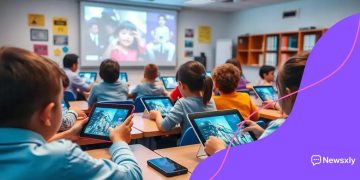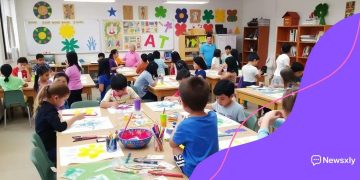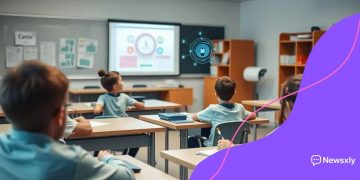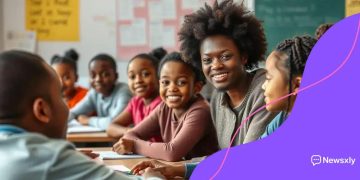Curriculum flexibility pilot: revolutionizing education now
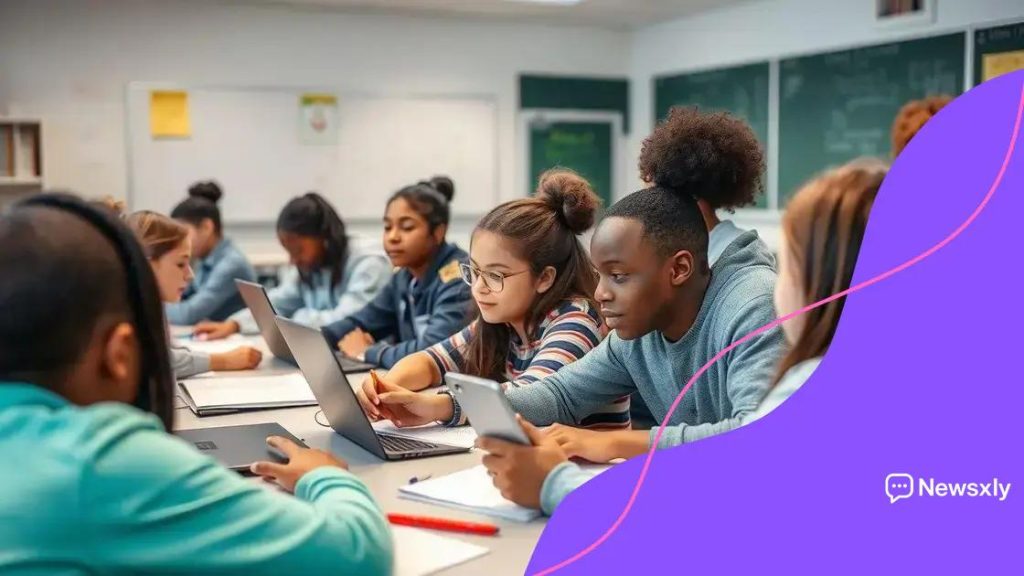
Curriculum flexibility pilot enhances personalized learning by allowing students to choose their learning paths, fostering engagement and improving educational outcomes through tailored educational experiences.
Curriculum flexibility pilot is transforming how students engage with their education. Imagine a learning environment tailored to individual needs, allowing each student to thrive at their own pace. In this article, we’ll delve into what makes this approach groundbreaking and how it can enhance educational experiences.
Understanding curriculum flexibility
Understanding curriculum flexibility is essential to grasp how education can cater more to individual student needs. This concept allows learners to explore subjects at their own pace, creating a more personalized learning experience.
In this approach, each student’s unique strengths and interests are taken into account, making their educational journey more engaging and effective. The idea is to break away from the traditional one-size-fits-all method and to foster a more adaptable learning environment.
Key Concepts of Curriculum Flexibility
There are several key concepts that underline the importance of curriculum flexibility:
- Personalization: Tailoring education to fit the learner’s needs.
- Choice: Allowing students to select subjects or projects that interest them.
- Technology Integration: Using digital tools to enhance learning experiences.
This flexibility can significantly impact how students perceive their education. When students have a say in their learning, it not only boosts their motivation but helps them develop critical thinking skills. As they engage more with the material, they also develop a deeper understanding of the content.
Through various teaching methods, such as project-based learning and collaborative tasks, educators can provide students with the freedom to excel in their preferred styles. Each of these methods contributes to a balanced approach, fostering an atmosphere where students can thrive.
Advantages of Flexible Curriculum
The benefits of a flexible curriculum extend well beyond student satisfaction. Here are a few advantages that stand out:
- Increased Engagement: Students are more likely to engage when they have choices that resonate with them.
- Enhanced Learning Outcomes: Personalized learning paths often lead to better understanding and retention of information.
- Life Skills Development: Flexibility encourages students to take responsibility for their learning.
As education continues to evolve, understanding how curriculum flexibility shapes the learning landscape becomes more important. It provides a roadmap for educators to innovate and adapt their teaching strategies.
Incorporating examples from various education systems worldwide can also provide insights into how effective curriculum flexibility has been implemented. These examples demonstrate how schools can create supportive environments that prioritize individualized learning.
Key benefits of a flexibility pilot
Implementing a flexibility pilot in education can bring numerous advantages that enhance both teaching and learning experiences. This innovative approach allows students to customize their learning paths, which can lead to greater motivation and success.
One of the most significant benefits is increased student engagement. When students have more control over their learning, they feel more invested in their education. This leads to a more active participation in class discussions and activities.
Advantages of a Flexibility Pilot
- Personalized Learning: Students can focus on areas they are passionate about, making learning relevant to them.
- Improved Outcomes: Tailored educational experiences often result in better academic performance.
- Enhanced Learning Skills: Students develop critical thinking and problem-solving abilities by navigating their own educational journeys.
The flexibility pilot also promotes collaboration among students, encouraging them to work together on projects and share ideas. This cooperative environment enhances social skills and fosters teamwork, essential skills for the future.
Another key benefit is that educators gain valuable insights into student needs and preferences. By observing how students respond to different approaches, teachers can refine their methods to be more effective.
Long-Term Impact
In the long run, implementing a flexibility pilot can lead to systemic changes in how education is delivered. Schools that embrace this model may see higher graduation rates and greater student satisfaction, which can positively affect their reputation.
By prioritizing student choice and adaptability, educational institutions can cultivate an environment where every learner can thrive. As we continue to evolve in our understanding of effective teaching strategies, the benefits of flexibility will only become more apparent.
Implementing a successful flexibility pilot

Implementing a successful flexibility pilot requires careful planning and execution. This process allows educators to adapt their curriculum to better meet student needs and preferences. Schools must start by defining clear goals and objectives for the pilot.
One key aspect of the implementation process is involving all stakeholders in the planning phase. Teachers, students, and parents should have input on how the pilot will be structured. This collaboration ensures that everyone is on board and supports the changes being made in the classroom.
Steps for Successful Implementation
- Define Objectives: Clearly articulate what the pilot aims to achieve, such as increased engagement or improved academic performance.
- Gather Resources: Ensure that there are adequate resources, such as technology and training for teachers, to support the pilot.
- Set a Timeline: Establish a timeline for the pilot process, including key milestones and evaluation points.
Once the planning is completed, it is important to pilot the program in a few classes before a full rollout. Feedback collected during this phase is invaluable. It helps identify what works well and what adjustments may be needed.
Another crucial element is providing ongoing support to teachers. Regular training sessions allow educators to become familiar with the new methods. This support can include sharing best practices and resources to enhance their teaching strategies.
Monitoring and Assessment
As the pilot progresses, implementing a system to monitor student progress is essential. This can involve regular assessments and surveys to gather student feedback. By analyzing this data, schools can make informed decisions about how to adjust the curriculum to better meet their students’ needs.
Additionally, maintaining open lines of communication with all stakeholders ensures transparency throughout the process. Updates on the pilot’s progress and outcomes can help build trust and support among the school community.
Challenges in curriculum flexibility
Implementing curriculum flexibility brings many advantages, but it also poses several challenges that educators must navigate. These challenges can impact the pilot’s success and effectiveness.
One major challenge is the resistance to change among educators. Many teachers are accustomed to traditional teaching methods, and shifting to a more flexible approach may feel daunting. This resistance can stem from fear of the unknown or a lack of confidence in using new strategies.
Common Challenges
- Training Needs: Educators may require extensive training to adapt to flexible teaching methods.
- Resource Allocation: Schools need to allocate resources effectively to support flexible learning environments.
- Curriculum Alignment: Ensuring that the flexible curriculum aligns with educational standards can be tricky.
Another significant issue is managing diverse student needs within the same classroom. Each student has unique learning styles and paces, making it essential for teachers to tailor their approaches. This differentiation requires time and effort, which can be challenging for teachers already facing heavy workloads.
Furthermore, assessing student progress in a flexible curriculum can be complex. Traditional assessment methods may not capture the full range of student learning and creativity. Teachers may need to develop new ways to evaluate progress that align with flexible learning practices.
Communication and Collaboration
Effective communication among educators is vital when implementing flexibility. Teachers must collaborate and share insights to refine their strategies continually. Additionally, involving parents and the community can help ease the transition by providing support and understanding of the new methods.
Despite these challenges, overcoming them can lead to a more effective educational experience. Through careful planning and ongoing support, schools can successfully implement flexible curriculum approaches.
Future trends in flexible education
The landscape of education is continually evolving, and future trends in flexible education suggest exciting possibilities. As technology advances and society changes, educators are finding new ways to engage students.
One trend is the increasing use of personalized learning platforms. These digital tools allow students to learn at their own pace and focus on their interests. This shift promotes a more engaging experience and helps students take ownership of their education.
Emerging Trends
- Blended Learning: Combining in-person and online learning experiences provides flexibility and accessibility.
- Project-Based Learning: Engaging students in real-world projects fosters creativity and critical thinking, essential skills for the future.
- Competency-Based Education: This approach allows students to progress based on their mastery of skills rather than time spent in class.
Another important trend is the shift towards social-emotional learning (SEL). As schools focus on the whole student, SEL programs help develop emotional intelligence and resilience, critical for success in a flexible learning environment.
Additionally, educators are embracing the value of collaboration and community. Future trends indicate a stronger emphasis on partnerships with businesses and organizations, creating opportunities for internships and real-world experiences. This aligns learning with career readiness, equipping students with the necessary skills.
Technology’s Role
Advancements in technology are also driving changes in flexible education. Tools like virtual reality (VR) and augmented reality (AR) provide immersive learning experiences that captivate students. These technologies can bring complex subjects to life, making learning fun and interactive.
Moreover, mobile devices and applications are becoming integral in education, allowing students to access resources anytime, anywhere. This flexibility supports varied learning styles and provides opportunities for continuous learning beyond the classroom.
FAQ – Questions about Flexible Education Implementation
What is curriculum flexibility?
Curriculum flexibility allows students to learn at their own pace and choose subjects that interest them, promoting personalized education.
What are the benefits of a flexibility pilot?
A flexibility pilot can increase student engagement, improve learning outcomes, and foster critical thinking skills by allowing personalized learning paths.
What challenges might educators face when implementing a flexible curriculum?
Educators may encounter resistance to change, the need for additional training, and difficulties in assessing student progress effectively.
How can technology aid in flexible education?
Technology integration, like blended learning and personalized learning platforms, enhances flexibility by providing more adaptive learning experiences for students.

